Hukou Waterfall: Nature’s Majestic Symphony on the Yellow River

An Essential Guide to Visiting Hukou Waterfall Of The Yellow River Tourism Area
In This Guide
- An Essential Guide to Visiting Hukou Waterfall Of The Yellow River Tourism Area
- The Rich History and Legends of Hukou Waterfall Of The Yellow River Tourism Area
- Main Highlights: What You Absolutely Can’t Miss
- Planning Your Visit: A Practical Guide
- Tickets: Prices, Booking, and Tips
- How to Get There: A Complete Transportation Guide
- Local Cuisine and Accommodation Nearby
- Frequently Asked Questions
- Final Thoughts on Your Trip
Discover the Majestic Hukou Waterfall: A Natural Wonder of China
Nestled at the border between Shanxi and Shaanxi provinces, Hukou Waterfall is not just a breathtaking natural wonder; it is a pivotal piece of China’s cultural tapestry. As the second-largest waterfall in the country and the largest on the storied Yellow River, Hukou is often referred to as “the only yellow waterfall in the world.” This spectacular site draws visitors with its stunning views and rich history, making it a must-see for travelers eager to explore the beauty and heritage of China.
At a staggering 300 meters wide, the Yellow River suddenly narrows to just 20 meters before plunging into a dramatic gorge, creating a thundering cascade that can be heard from miles away. The water’s unique yellow hue, rich with silt and sediment, adds to the waterfall’s allure and its significance as a symbol of the river that has shaped Chinese civilization for millennia.
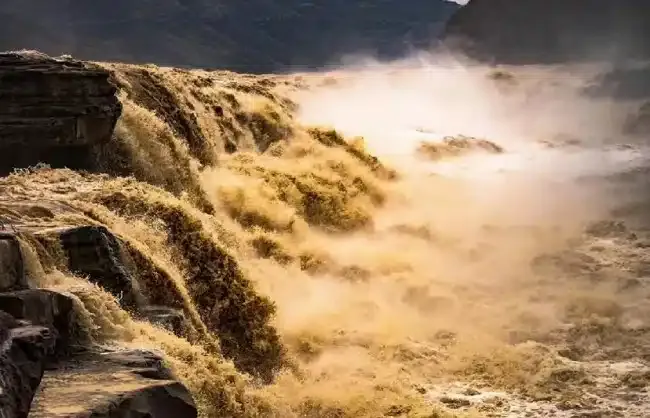
Hukou_Waterfall_Of_The_Yellow_River_Tourism_Area.
Visiting Hukou Waterfall is an adventure that goes beyond mere sightseeing; it is an opportunity to stand in awe of nature’s power while reflecting on the ancient stories of the Yellow River, often dubbed the “Mother River” of China. The journey to the waterfall can be as rewarding as the destination itself, with scenic views and cultural landmarks dotting the route from nearby cities like Xi’an.
Whether you are a history enthusiast, a photography lover, or simply seeking a unique experience, Hukou Waterfall offers a captivating glimpse into the natural beauty and cultural significance of China. Prepare to be enchanted by the roar of the water, the breathtaking scenery, and the rich narratives that surround this iconic landmark.

Hukou_Waterfall_Of_The_Yellow_River_Tourism_Area.
The Rich History and Legends of Hukou Waterfall Of The Yellow River Tourism Area
A Tapestry of History and Legends at Hukou Waterfall
Nestled along the majestic Yellow River, the Hukou Waterfall is more than just a stunning natural wonder; it is a site steeped in rich history and enveloped in captivating legends. As the second-largest waterfall in China and the largest on the Yellow River, it holds a unique place in both the geographical and cultural landscapes of the region.
Historical Significance
The Hukou Waterfall is located at the border of Shanxi and Shaanxi provinces, a strategic point that has witnessed centuries of civilization. The Yellow River, often referred to as the “Mother River” of China, has been a lifeline for countless dynasties, providing water, sustenance, and fertile soil for agriculture. The waterfall itself is a testament to the river’s tumultuous journey, where its 300-meter width suddenly constricts to a mere 20 meters, creating a spectacular cascade that has awed visitors for generations.
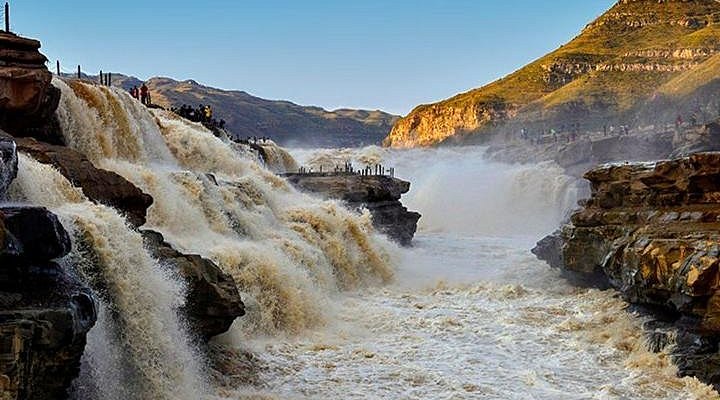
Hukou_Waterfall_Of_The_Yellow_River_Tourism_Area.
Historically, the area surrounding the waterfall has been inhabited since ancient times. Archaeological findings reveal that early Chinese civilizations flourished in the fertile plains of the Yellow River Valley. This region served as the cradle of Chinese culture, and the river is often invoked in poetry and philosophy, symbolizing the ebb and flow of life.
Legends and Folklore
The Hukou Waterfall is not just a natural spectacle; it is also a canvas for a variety of legends that have been passed down through generations. One of the most famous legends tells the tale of a dragon that once roamed the Yellow River. According to folklore, the dragon was a protector of the river, ensuring that the waters remained pure and bountiful. However, when the dragon fell asleep, the river became turbulent, leading to the creation of the Hukou Waterfall as the water surged violently through the gorge.
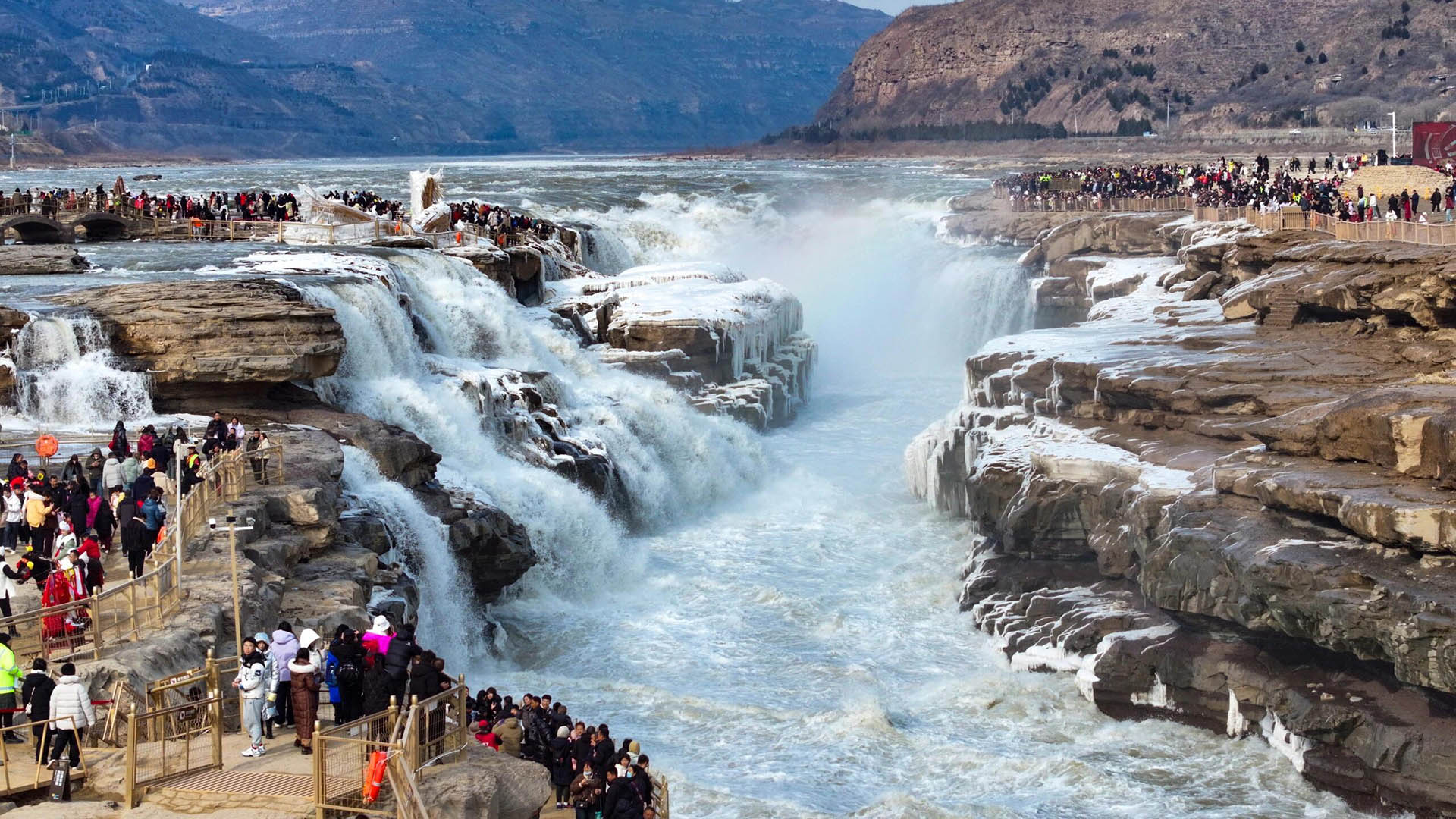
Hukou_Waterfall_Of_The_Yellow_River_Tourism_Area.
Another enchanting tale speaks of a beautiful fairy who lived near the waterfall. It is said that she would descend from the heavens to bathe in the golden waters, enchanting all who witnessed her beauty. Locals believed that the waterfall was imbued with her spirit, and those who visited it would be blessed with good fortune and prosperity.
Additionally, the unique yellow color of the water—caused by the high levels of silt, sand, and rock—has led to various interpretations. Some believe it symbolizes the resilience and tenacity of the Chinese people, who have thrived despite the challenges posed by nature.
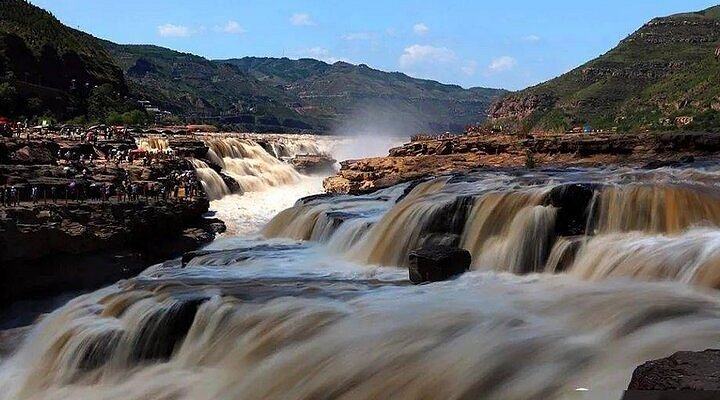
Hukou_Waterfall_Of_The_Yellow_River_Tourism_Area.
Cultural Impact
The Hukou Waterfall has not only inspired legends but has also influenced art, literature, and philosophy throughout Chinese history. Poets have immortalized its beauty in verses, while painters have captured its splendor on canvas. The waterfall serves as a reminder of nature’s power and beauty, prompting reflection on humanity’s relationship with the environment.
In modern times, the Hukou Waterfall continues to attract visitors from around the globe, drawn not only by its breathtaking views but also by its rich historical and cultural significance. The area serves as a poignant reminder of the intertwining of nature and human culture, making it an essential stop for travelers seeking to understand the depth of Chinese history.
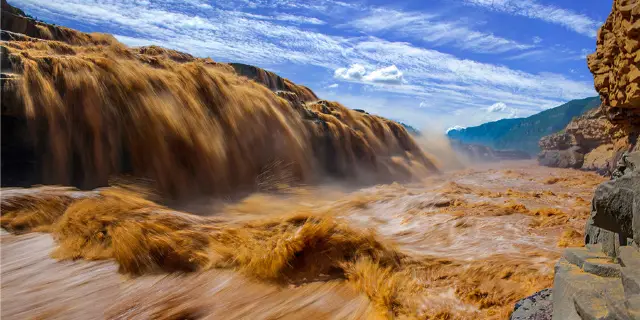
Hukou_Waterfall_Of_The_Yellow_River_Tourism_Area.
Conclusion
Visiting the Hukou Waterfall is not merely a sightseeing adventure; it is an opportunity to immerse oneself in the stories and legends that have shaped this remarkable region. As you stand before the thundering waters, take a moment to reflect on the rich tapestry of history and folklore that surrounds you, and let the spirit of the Yellow River reveal its ancient secrets.
Main Highlights: What You Absolutely Can’t Miss
Discover the Majestic Hukou Waterfall: A Natural Wonder on the Yellow River
When visiting China, few natural spectacles can rival the breathtaking Hukou Waterfall, the second largest waterfall in the country and the largest on the iconic Yellow River. This awe-inspiring destination is a must-see for travelers interested in Chinese history, culture, and the raw power of nature. Here are the highlights that you absolutely can’t miss during your visit to this remarkable site.
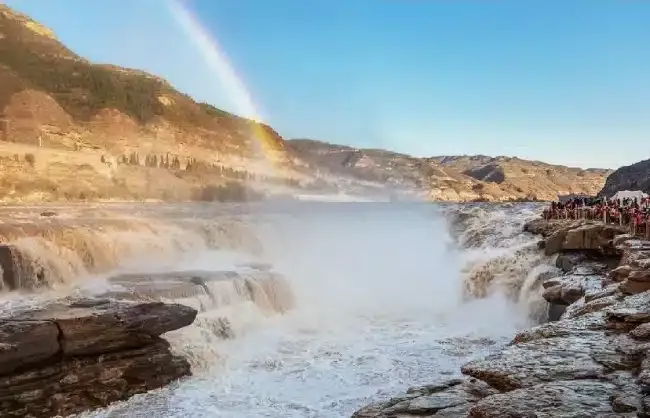
Hukou_Waterfall_Of_The_Yellow_River_Tourism_Area.
1. The Waterfall Itself: Nature’s Masterpiece
Hukou Waterfall stretches an impressive 300 meters wide, where the Yellow River suddenly narrows to a mere 20 meters before plunging a staggering 20 meters into a gorge. This dramatic transformation creates a thunderous cascade that is often described as the “only yellow waterfall in the world,” thanks to the silt and sediment that give the water its distinctive hue. The sound of the water crashing down is a symphony of nature, echoing through the valleys and creating an unforgettable auditory experience.
2. Stunning Viewing Points
There are viewing platforms on both the Shanxi and Shaanxi sides of the waterfall, each offering unique perspectives that enhance your experience:
-
Shanxi Side: Here, you can marvel at the full length of the waterfall, capturing its grandeur and the surrounding landscape. This side is particularly popular for photography, especially in the afternoon when the light is at its best.
-
Shaanxi Side: This vantage point allows you to witness the power of the Yellow River as it plunges into the gorge. It’s an incredible view that emphasizes the river’s sheer force and is perfect for those looking to appreciate the dramatic height of the fall.

Hukou_Waterfall_Of_The_Yellow_River_Tourism_Area.
3. A Rich Historical Context
The Hukou Waterfall is not just a natural wonder; it is steeped in rich cultural and historical significance. The Yellow River, known as the “cradle of Chinese civilization,” has been a vital lifeline for the Chinese people for millennia. A visit to the waterfall offers a glimpse into the historical narratives that have unfolded along its banks, making it a poignant experience for those interested in China’s vast history.
4. Experiencing Local Culture
While in the area, take the opportunity to explore nearby attractions that showcase local culture. Consider a visit to Dangjia Village in Hancheng, known for its traditional architecture and rich agricultural heritage. This can be a perfect addition to your itinerary, allowing you to immerse yourself further in the regional culture and enjoy the scenic countryside.

Hukou_Waterfall_Of_The_Yellow_River_Tourism_Area.
5. Practical Information for Travelers
-
Best Time to Visit: The waterfall can be visited year-round, but the best time is during the rainy season (June to August) when the flow is at its peak, creating an awe-inspiring spectacle. However, be cautious of slippery paths and potential flooding.
-
Entrance Fees: The standard entrance fee is RMB100 for the head-on view, with a reduced fee of RMB50 for the rear view. Shuttle buses are available for RMB10 per person, making it easy to navigate the area.
-
Travel Logistics: The waterfall is about a 3.5-hour drive from Xi’an, making it an ideal day trip. Consider joining a guided tour to enhance your understanding of the area’s history and significance.
6. Capturing the Moment
Don’t forget your camera! The unique yellow color of the water and the dramatic scenery are perfect for photography. Just be sure to protect your lens from the fine mist generated by the waterfall to keep your shots pristine.
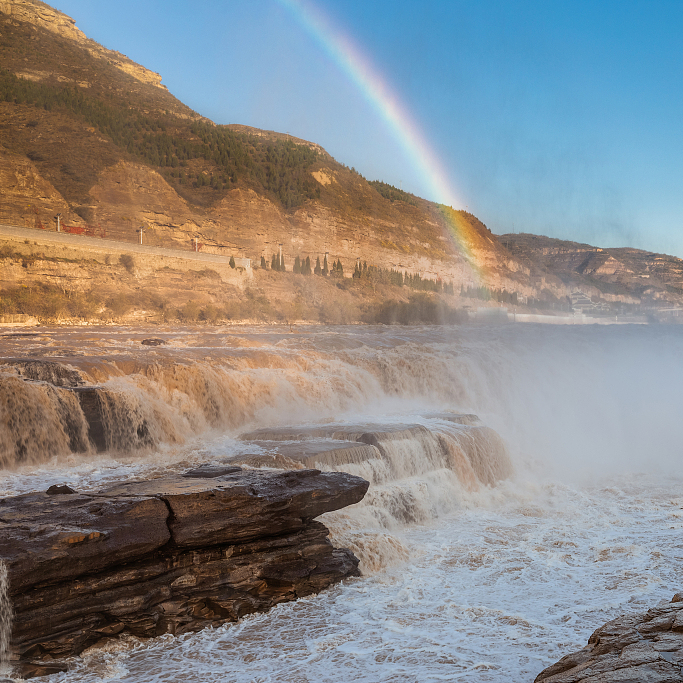
Hukou_Waterfall_Of_The_Yellow_River_Tourism_Area.
In Conclusion
Hukou Waterfall is more than just a scenic spot; it is a profound experience that connects travelers to the history, culture, and natural beauty of China. Whether you’re awed by its sheer size, intrigued by its historical significance, or simply captivated by the beauty of nature, this destination promises to leave a lasting impression. Plan your visit and immerse yourself in the grandeur of one of China’s most extraordinary natural wonders.
Planning Your Visit: A Practical Guide
Essential Information for Your Visit to Hukou Waterfall
Hukou Waterfall, often referred to as the “Yellow Waterfall,” is a stunning natural wonder located at the confluence of Shanxi and Shaanxi provinces along the legendary Yellow River. Renowned as the second largest waterfall in China, it offers travelers a unique glimpse into the power and beauty of nature, intertwined with rich cultural history. Here’s all you need to know for a memorable visit.
Best Time to Visit
The optimal time to experience Hukou Waterfall is during the late spring to early autumn (May to October). This period generally offers milder weather and clearer views. However, if you want to witness the waterfall at its most majestic, consider visiting during the rainy season (June to September), when the water flow is at its peak. Be mindful, though, that heavy rains can lead to flooding and road closures.
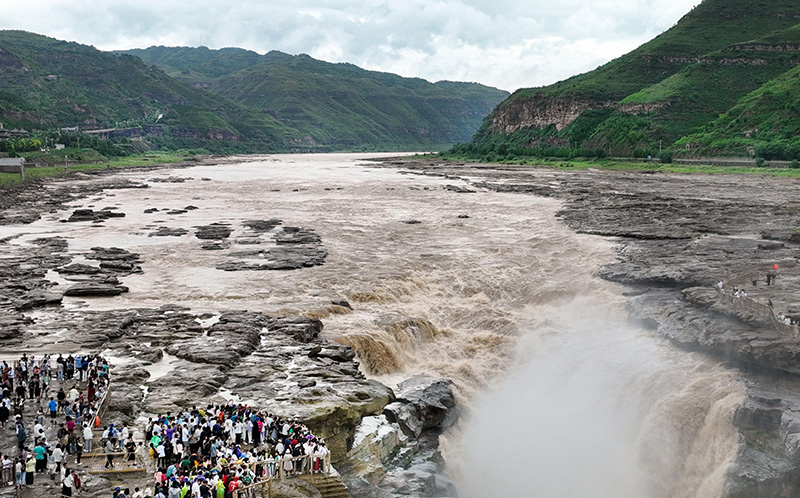
Hukou_Waterfall_Of_The_Yellow_River_Tourism_Area.
Opening Hours
- Daily Hours: 8:00 AM – 6:00 PM
Entrance Fees
- Head-On View: RMB 100
- Rear View: RMB 50
- Shuttle Bus: RMB 10 (one way)
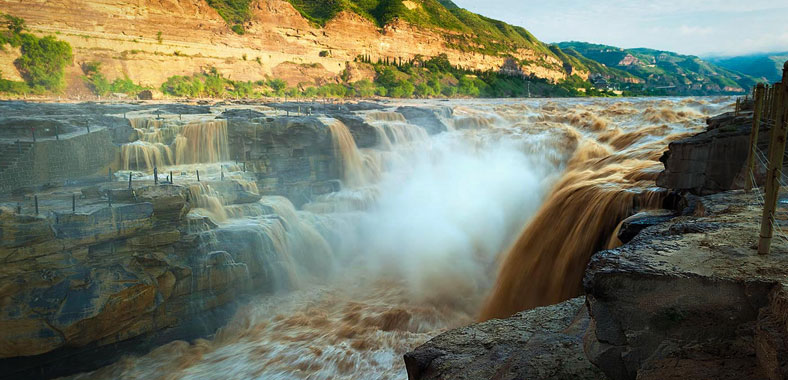
Hukou_Waterfall_Of_The_Yellow_River_Tourism_Area.
Getting There
Hukou Waterfall is situated approximately 3.5 to 4 hours from Xi’an, making it an ideal day trip. Here are a few travel options:
- By Car: Renting a car offers the flexibility to explore nearby attractions at your own pace.
- By Tour: Several tour operators offer day trips from Xi’an, often combining visits to the waterfall with stops at historical sites like the Huangdi Mausoleum or Dangjia Village.
Viewing Tips
- Best Viewing Points: For the most breathtaking views, visit the Shannxi side of the waterfall, where you can appreciate the full breadth of the fall. The Shanxi side offers a closer look at the gorge.
- Photography: The afternoon light is more favorable on the Shannxi side, so plan your visit accordingly. Be cautious of water droplets that can fog your camera lens.
- Safety First: Keep a safe distance from the riverbank, as the currents can be unpredictable.
Nearby Attractions
Enhance your visit by exploring these nearby sites:
- Yumao Peak: Experience stunning mountain views and hiking trails.
- Jedi Trail: A great option for hiking enthusiasts looking for adventure.
- Shizitan Site: A historic site to delve into the local culture and heritage.
Practical Considerations
- Weather: Check the forecast before your visit, as rain can make the ground slippery and affect visibility.
- Facilities: Clean restroom facilities are available at the ticket area, which is a plus for travelers.
- Crowds: Expect fewer crowds compared to other major tourist attractions, allowing for a more intimate experience with nature.
Conclusion
A visit to Hukou Waterfall is not just about witnessing a natural spectacle; it’s a journey into the heart of China’s geography and cultural heritage. Whether you’re an avid nature lover, a history buff, or simply looking for a stunning photo opportunity, this remarkable site offers a unique experience that will leave lasting memories. Plan ahead, stay safe, and relish the majestic beauty of one of China’s hidden gems.
Tickets: Prices, Booking, and Tips
Essential Ticket Information for Visiting Hukou Waterfall
Planning a trip to the majestic Hukou Waterfall, the second largest waterfall in China, requires some insight into ticketing, pricing, and practical tips to enhance your visit. Here’s everything you need to know to make the most of your experience.
Entrance Fees
- Main Viewing Area:
- Price: RMB 100 (approximately $15)
-
This ticket allows you to access the prime viewing point of the waterfall, where you can witness the full force of the Yellow River plummeting through the gorge.
-
Rear Viewing Area:
- Price: RMB 50 (approximately $7.50)
- For those who want a different perspective, this ticket grants access to a less crowded viewing point.
Shuttle Bus
To reach the waterfall from the parking area, a shuttle bus is available:
– Cost: RMB 10 per person (one way)
– This bus service is essential, as the walk to the waterfall can be quite lengthy and is not recommended for those who may have mobility issues.
Operating Hours
- Daily Hours: 8:00 AM – 6:00 PM
- It’s advisable to arrive early in the day to avoid crowds and enjoy the serene beauty of the waterfall.
Best Time to Visit
- Afternoon Light: Visitors report that the afternoon sun provides the best lighting for photographs, especially from the Shannxi side, which faces east.
- Weather Considerations: Rainy weather can reduce visibility and make the ground slippery, so check the forecast before your visit. During monsoon season, access can be affected by flooding.
Booking Tips
- Advance Booking: Although tickets can be purchased on-site, consider booking in advance through a local travel agency or online platforms to avoid the hassle of long lines, especially during peak tourist seasons.
- Combine Your Itinerary: Given the distance from major cities like Xi’an (approximately 3.5 to 4 hours), it’s wise to plan a day trip that includes nearby attractions such as the Huangdi Mausoleum or Dangjia Village.
What to Bring
- Camera Protection: The spray from the waterfall can leave your camera lens misty; bringing a protective cover or lens cloth is advisable.
- Comfortable Footwear: Wear sturdy shoes for walking around the viewing areas, as paths can be uneven and muddy.
Overall Experience
Visiting Hukou Waterfall is not just about witnessing a natural wonder; it’s a chance to immerse yourself in the rich history and culture surrounding the Yellow River, a vital artery of Chinese civilization. With proper planning regarding tickets and logistics, your trip to this unique landmark will surely be a memorable highlight of your travels in China.
How to Get There: A Complete Transportation Guide
Getting to Hukou Waterfall: A Comprehensive Transportation Guide
Nestled at the confluence of Shanxi and Shaanxi provinces, Hukou Waterfall is not only the second largest waterfall in China but also an awe-inspiring natural wonder that attracts visitors from around the globe. As you plan your journey to this breathtaking site, understanding the transportation options available will make your trip seamless and enjoyable. Here’s a detailed guide to getting there.
1. By Air
The nearest major airport to Hukou Waterfall is Xi’an Xianyang International Airport (XIY), located approximately 150 kilometers (about 93 miles) away. This airport serves both domestic and international flights, making it a convenient entry point for international travelers.
- From the Airport to Hukou Waterfall:
- Taxi: The simplest way to reach Hukou Waterfall from the airport is by taxi. The journey will take about 2.5 to 3 hours, depending on traffic, and the fare is approximately 350-400 RMB.
- Airport Shuttle to Xi’an City: Alternatively, you can take the airport shuttle to Xi’an city center and then proceed from there.
2. By Train
Xi’an is well-connected via high-speed rail, making it an ideal base for your trip to Hukou Waterfall.
- Train Stations: Head to Xi’an North Railway Station, which hosts frequent high-speed trains.
- Train to Yuncheng: Take a high-speed train towards Yuncheng. The journey takes approximately 2 hours. Once in Yuncheng, you will need to continue your journey to Hukou Waterfall.
3. By Road
Traveling by road offers flexibility and the opportunity to enjoy the scenic views of rural China.
-
Self-Drive: Renting a car gives you the freedom to explore at your own pace. The drive from Xi’an to Hukou Waterfall takes about 3-4 hours. Follow the G65 expressway and then switch to local roads leading to Hukou Town.
-
Bus Services: Several bus companies operate routes from Xi’an to Hukou Waterfall.
- Departure Points: Buses usually depart from Xi’an’s main bus station.
- Duration: The bus ride typically takes around 4-5 hours, and tickets cost approximately 70-100 RMB.
4. Organized Tours
If you prefer a hassle-free experience, consider joining an organized tour. Many travel agencies offer day trips to Hukou Waterfall from Xi’an, which often include:
- Transportation: Round-trip transportation in comfortable vehicles.
- Guided Tours: Knowledgeable guides who provide insights into the history and significance of the waterfall.
- Additional Visits: Many tours combine a visit to the waterfall with other nearby attractions, such as the Huangdi Mausoleum.
5. Local Transportation
Once you arrive at Hukou Waterfall, the area is well-equipped for visitors.
- Shuttle Buses: Within the park, shuttle buses are available to take visitors to various viewing points of the waterfall. A ticket for the shuttle bus costs around 10 RMB per trip.
- Walking Trails: There are well-maintained walking paths that allow you to explore the surrounding areas and view the waterfall from different angles.
Tips for Your Journey
- Weather Conditions: Keep in mind that weather can affect travel plans, especially during monsoon season. Roads may be closed due to flooding, so check local conditions before setting out.
- Photography: For the best photographs, visit the Shannxi side in the afternoon when the light is optimal.
- Safety Precautions: Stay a safe distance from the riverbank as the powerful currents can be treacherous.
Conclusion
With various transportation options available, getting to Hukou Waterfall is an accessible and rewarding experience. Embrace the journey, soak in the stunning landscapes, and prepare to be awed by one of China’s natural treasures. Whether you’re an adventurer seeking the thrill of the waterfall or a history enthusiast eager to delve into the region’s rich past, your trip to Hukou Waterfall promises to be unforgettable.
Local Cuisine and Accommodation Nearby
Savoring Local Flavors and Comforting Stays Near Hukou Waterfall
Visiting the Hukou Waterfall is not only about witnessing the breathtaking natural wonder; it’s also an opportunity to immerse yourself in the rich local culture and cuisine. The area surrounding the waterfall, straddling both Shanxi and Shaanxi provinces, offers a delightful array of traditional dishes and comfortable accommodations that reflect the region’s heritage.
Culinary Delights
-
Yellow River Fish (黄河鲤鱼)
This iconic dish features fish caught from the Yellow River, often steamed or braised with a fragrant soy sauce, ginger, and garlic. The tender, flaky meat is a must-try for anyone visiting the area. -
Shanxi Noodles (山西刀削面)
Known for their unique texture and flavor, these hand-cut noodles are a staple in Shanxi cuisine. Served with a variety of sauces—ranging from spicy to savory—they make for a hearty meal after a day of exploring. -
Shaanxi Roujiamo (肉夹馍)
This “Chinese hamburger” consists of flavorful braised pork packed into a warm, freshly baked bun. It’s perfect for a quick bite before heading to the waterfall. -
Qin Beef Noodle Soup (秦牛肉面)
A local favorite, this dish features tender beef slices in a rich broth, complemented by hand-pulled noodles. It’s a comforting option, particularly on cooler days. -
Local Snacks
Keep an eye out for local street vendors selling snacks like Jiaozi (饺子) and Mao Er Duo (毛儿多), a type of sweet fried pastry. These treats are great for refueling during your adventures.
Where to Stay
To enhance your experience, consider staying at one of the charming accommodations near the Hukou Waterfall, each offering a blend of comfort and local charm.
-
Hukou Waterfall Hotel (壶口瀑布酒店)
Located conveniently close to the waterfall, this hotel offers stunning views and comfortable rooms. Guests appreciate the friendly service and the option to enjoy local cuisine at the on-site restaurant. -
Yuan Yang Hotel (元阳酒店)
Situated in Ji County, this hotel provides a cozy atmosphere with traditional decor. It features modern amenities and is ideal for families or travelers looking for a relaxing stay after a day of exploring. -
Dangjia Village Homestay (当家村民宿)
For a more authentic experience, consider a stay at a homestay in nearby Dangjia Village. Here, you can interact with local families, enjoy home-cooked meals, and learn about the region’s culture and history. -
Xianyu Hotel (仙宇酒店)
This option is slightly further away but offers a peaceful retreat with beautiful gardens and a warm ambiance. The attentive staff is eager to assist guests with travel plans and recommendations. -
Hostels in Ji County
If you’re traveling on a budget, several hostels in Ji County offer shared dormitories and private rooms. These are perfect for meeting fellow travelers and sharing stories about your adventures.
Conclusion
The Hukou Waterfall area is not just a destination for nature lovers; it’s a place where you can indulge in local culinary delights and find accommodations that enhance your travel experience. Whether you’re enjoying the rich flavors of the region or resting after a day of exploration, you’ll find that the hospitality and culture of Shanxi and Shaanxi provinces make your visit truly memorable.
Frequently Asked Questions
Frequently Asked Questions about Hukou Waterfall
1. What is Hukou Waterfall known for?
Hukou Waterfall is the second largest waterfall in China and the largest on the Yellow River. It is renowned for its unique yellow color, attributed to the silt and sediment carried by the river, making it famously known as “the only yellow waterfall in the world.”
2. Where is Hukou Waterfall located?
The waterfall is situated on the border between Shanxi and Shaanxi provinces, near Ji County. The breathtaking natural site can be accessed from both sides of the river, providing different perspectives of the waterfall.
3. What are the visiting hours and entrance fees?
Hukou Waterfall is open daily from 8:00 AM to 6:00 PM. The entrance fee is approximately RMB 100 for the head-on view and RMB 50 for the rear view. Shuttle buses are available for RMB 10 per person each way.
4. What is the best time to visit Hukou Waterfall?
The optimal time to visit is during the late spring to early autumn (May to October) when the weather is mild and the waterfall is often at its most magnificent. However, be cautious of the rainy season, as heavy rains can lead to flooding and slippery conditions.
5. Can I visit Hukou Waterfall as a day trip?
Yes, many travelers opt for day trips from nearby cities like Xi’an. It is advisable to combine your visit with other nearby attractions, such as the Huangdi Mausoleum or Dangjia Village, to make the most of your itinerary.
6. What should I bring for my visit?
Visitors should wear comfortable shoes suitable for walking. Additionally, a camera is a must to capture the stunning views, but ensure to protect it from water spray. It’s also wise to bring water, snacks, and sun protection, as facilities may be limited on-site.
7. Is it safe to approach the waterfall?
While it is safe to view the waterfall from designated areas, visitors should maintain a safe distance from the riverbank due to strong currents and slippery surfaces. It’s always best to heed any posted safety warnings.
8. Are there guided tours available?
Yes, guided tours to Hukou Waterfall are available from various travel agencies, offering insights into the area’s history and natural significance. These tours often include transportation and the option to visit nearby attractions. It’s a great way to enhance your experience and learn more about this remarkable site.
Final Thoughts on Your Trip
As you wrap up your journey to the magnificent Hukou Waterfall, take a moment to reflect on the natural beauty and historical significance that surrounds this stunning site. Nestled at the confluence of Shanxi and Shaanxi provinces, Hukou is not just a spectacle of nature; it is a powerful symbol of the enduring spirit of the Yellow River, a river that has shaped the landscape and culture of China for millennia.
A Unique Experience Awaits
The Hukou Waterfall, often referred to as “the only yellow waterfall in the world,” captivates visitors with its sheer size and tumultuous energy. As the Yellow River narrows and plunges through its gorge, the vibrant hues of yellow—resulting from the rich silt—create an awe-inspiring sight that is unlike any other. Whether you view it from the Shanxi or Shaanxi side, each perspective offers a unique appreciation for this natural wonder.
Plan for the Perfect Visit
To make the most of your visit, consider the following tips:
- Timing Matters: The afternoon light enhances photography, especially from the Shaanxi side, where you can capture the full expanse of the falls.
- Travel Prepared: Given the potential for rain and slippery conditions, plan your visit during dry seasons and always check weather forecasts before your trip.
- Combine Your Itinerary: The distance from major cities like Xi’an makes it beneficial to pair your visit with nearby attractions such as the historic Dangjia Village, enriching your experience of this culturally rich region.
Embrace the Journey
As you leave, carry with you the echoes of the thundering waters and the stories of those who have walked these shores long before you. The Hukou Waterfall is more than just a destination; it is a reminder of the forces of nature and history that continue to shape the world. Allow this experience to inspire you, and may it ignite your curiosity for further exploration of China’s breathtaking landscapes and rich cultural heritage. Safe travels on your next adventure!